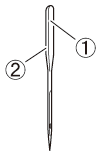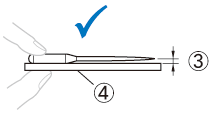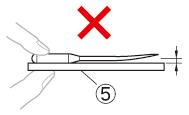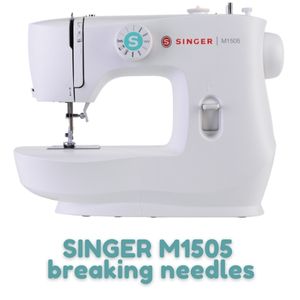SINGER M1505 Sewing machine breaking needles
If you don’t take the necessary precautions when utilizing your SINGER M1505 sewing machine, it can cause its needles to bend and break. This could lead to poor stitch quality and harm your machine!
To avoid this from occurring, ensure that all of the following are done correctly: check for proper needle size, secure needle in bar properly, attach presser foot or attachment appropriately and don’t sew over pins at an angle. Taking these steps will guarantee a perfect stitching project every time with no worry of damage.
Why break needles on the sewing machine SINGER M1505?
If your SINGER M1505 sewing machine needle keeps breaking, you may need to investigate what is causing the issue instead of simply replacing it. There are various possible explanations for why a needle can break and a few fixes that you can attempt to resolve the problem. If any damage, no matter how small, is noticed on the needle then it should be changed in order to prevent disruption to your sewing.
Common Problems Causing A Needle Break in Sewing Machine SINGER M1505
There are 5 main problems that can cause a needle to break in a SINGER M1505 sewing machine:
- The needle on sewing machine SINGER M1505 is damaged, bent
- The needle on sewing machine SINGER M1505 is Dull
- Incorrect needle size for fabric
- Wrong SINGER M1505 sewing machine thread tension
- The wrong SINGER M1505 sewing machine presser foot is attached
Needle breakage can be caused by several problems with the SINGER M1505 sewing machine, so let’s explore them:
The needle on sewing machine SINGER M1505 is damaged, bent
When using a SINGER M1505 sewing machine, it is important to inspect the needle for any signs of damage or wear before beginning to sew. If needed, replace the needle with a sharper one. Working on heavier fabrics may cause strain on a worn or bent needle, resulting in breaking while stitching. Slowing down the stitching speed can also help prevent unnecessary damage.
The needle on sewing machine SINGER M1505 is Dull
The needle on the SINGER M1505 sewing machine should be inspected regularly to ensure that it is sharp and intact. To test if the needle is dull, you can use a pocket knife blade to scratch against it; if there is resistance, then it’s time for a replacement.
Depending on how much the SINGER M1505 sewing machine is used, needles should typically be changed every 8-10 hours of use to prevent skipped stitches, uneven lengths and poor quality seams. Taking care of your needle will help you create beautiful and professional looking projects that last long. If any sign of damage or dullness appears, replace the needle immediately.
How to check the needle on a SINGER M1505 sewing machine
To make sure your SINGER M1505 sewing machine needle is in optimal condition, it’s essential to check for a bend before use. Put the flat part of the needle on a level surface and confirm that both sides are even. If you find that your needle has been bent, do not attempt to sew with it!
A crooked or damaged tool could break while operating, causing harm to yourself and others nearby. To avoid this risk altogether, only utilize needles specifically designed for home sewing machines— doing so will guarantee they remain safe during usage.

(1) Flat side (2) Needle type marking
– Correct needle

(3) Parallel space (4) Flat surface
– Incorrect needle
If the needle is not even with the flat surface, it is bent. Do not use a bent needle.

(5) Flat surface
Incorrect needle size for fabric
When sewing with different fabrics, the size of the needle is key. If you use a too-large needle for the fabric type, it can cause excessive friction that could lead to the needle breaking. To ensure that you are using the correct needle size, look up its recommended size based on thread and fabric thickness in the Singer M1505 sewing machine manual. This will help to prevent needles from breaking and keep your projects looking their best.
Needle and thread combinations
Finding the perfect needle for your SINGER M1505 sewing machine requires evaluating factors such as thread and fabric type. Utilize the provided chart to discover suitable pairings of needles, threads, and fabrics that will guarantee flawless results!
It is indispensable to correlate needle size with the thread size and weight of fabric for successful sewing.
Important to know:
- Forging an improper combination like thick fabric such as denim with a small needle (e.g., 65/9 – 75/11) can be hazardous and cause potential harm, since the needle may break or bend when sewing. Additionally, it could yield irregular stitches that do not look uniform at all.
- Avoid using thread of weight 20 or below at all costs as it can result in an array of undesirable problems.
- For a secure and smooth stitch, choose a ball point needle (golden-hued) when working on stretch fabrics or materials that tend to overlook stitches.
- No matter what your fabric and thread type are, a needle size of 90/14 to 100/16 is the perfect choice when using transparent nylon thread.
- The lesser the thread number, the stronger its structure; and correspondingly, a larger needle number indicates thicker needles.
Wrong SINGER M1505 sewing machine thread tension
Thread tension is a crucial factor when sewing, as it helps avoid needle breakage. It should be adjusted depending on the weight of the fabric and thread being used. Both the upper and lower threads should also have equal weight to ensure that correct tension is applied to prevent needles from bending or snapping. This will help you get better results with your SINGER M1505 sewing machine.
The wrong SINGER M1505 sewing machine presser foot is attached
Using improper or incompatible presser foot with a SINGER M1505 sewing machine can cause needles to become damaged due to repeated strikes against it. To minimize risk, ensure that the right type of presser foot is used for each pattern and double-check that all corresponding settings are correctly adjustedcisely worded. This will protect needles from damage and help maintain good results.
How to set the presser foot on the SINGER M1505 sewing machine

To remove the presser foot, push it (e) away from its slot (c). For attachment, insert the pin of the foot into its holder. To unclip and attach a shank: raise the bar (a), then affix or detach as shown in Figure 2.
IMPORTANT: Don’t forget to switch off (“O”) your device when completing any of these tasks!
Conclusion
In conclusion, needle breakage on a SINGER M1505 sewing machine can be prevented by selecting the right type of needle for your fabric, adjusting the thread tension correctly according to the material, and ensuring that the correct type of presser foot is being used for each pattern.
By following these steps, you can protect your SINGER M1505 sewing machine needle from unnecessary breakage and ensure that it performs optimally. This will reduce the need for costly replacements and keep your sewing projects running smoothly. With proper care and maintenance, your SINGER M1505 sewing machine can guarantee flawless results!
